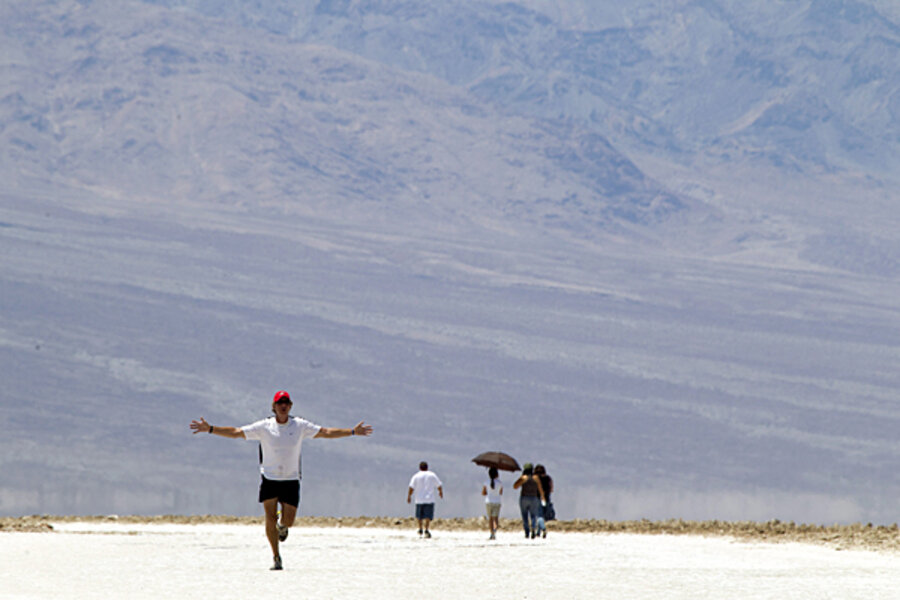Death Valley temps tie record in extreme heat wave
Loading...
| Los Angeles
A heat wave punishing several Western states brought at least record-tying temperatures to Death Valley and Las Vegas.
The mercury rocketed to 128 degrees Sunday in Death ValleyNational Park, the National Weather Service said, tying the record for the hottest June day anywhere in the country.
But the Los Angeles Times reported that the National Park Service thermometer — 200 yards away — recorded a temperature of 129.9, which shatters the record for June.
In Las Vegas, the temperature shot up to 117 degrees to tie the city's record high and to cause more discomfort for residents and tourists in the sprawling desert city.
Since record-keeping began in Las Vegas in 1937, the only other times the temperature reached 117 degrees were on July 19, 2005, and July 24, 1942, according to the National Weather Service.
Death Valley's the record high of 134 degrees set nearly a century ago on July 10, 1913, stands as the planet's highest recorded temperature.
Triple-digit heat struck again elsewhere in Southern California, while metropolitan Phoenix saw just a slight drop in temperatures after experiencing record-breaking heat Saturday.
Tragedy struck north of Phoenix as hot gusty winds fueled an out of control wild fire that overtook and killed 19 firefighters near the town of Yarnell.
Forestry spokesman Art Morrison said the firefighters were forced to deploy their fire shelters, tent-like structures meant to shield firefighters from flames and heat.
Six half-marathon runners in Southern California were hospitalized Sunday for heat-related illnesses. A day earlier, paramedics responding to a Nevada home without air conditioning found an elderly man dead.
Runners in the Southern California race who required medical attention were extremely dehydrated, and some experienced cramps, Pasadena Fire Department spokeswoman Lisa Derderian said. Several other runners were evaluated along the route but weren't taken to the hospital, she said.
Paramedics were deployed along the 13.1-mile race, and buses with air conditioning were provided for runners to cool off. The event was supposed to be a marathon, but it was downgraded due to low turnout last year.
Hikers, bikers and dog walkers were scarce on typically busy trails in the Santa Monica Mountains above Los Angeles. At midday, two women and a panting German shepherd huddled in a rare sliver of shade along a fire road before striking out in the hot sun.
Atop San Vicente Peak, cyclist Jeff Disbrow, 49, of Santa Monica was clad in black and lathered in sweat as he took a break and refilled his water bottle.
"It's not the best day to be out here — unless you want to suffer," he said. "It's like Arizona."
In Utah, a record 105-degree heat caused an interstate on-ramp to buckle in Salt Lake City, and hampered firefighters in their battle against three wildfires. The Interstate 215 on-ramp had to be closed for four hours Saturday night after a short section of it expanded, Utah Department of Transportation spokesman John Gleason said.
The section looked like a pothole before it was repaved, he said. No problems were reported, and traffic was rerouted around the closed lane.
Phoenix Fire Department spokesman Larry Nunez said the city hasn't seen any deaths that were classified as heat-related, but emergency workers have gotten 98 heat-related calls within the metro area since Friday morning.
The 119-degree high in Phoenix on Saturday marked the fourth-hottest day in metro Phoenix since authorities started keeping temperature records more than 110 years ago. The high temperature for the metro area hit 115 on Sunday.
Temperatures could drop slightly in Phoenix within the coming days as monsoon storms are expected to make their way through the state. Such storms could bring cloud cover but could produce more humidity and possibly contribute to dust storms.
Several Southern California communities set same-day record highs Saturday including Palm Springs, where the mercury peaked at 122 degrees. In Northern California, Redding reported a high of 110, Sacramento had 107 while Fresno saw 109.







